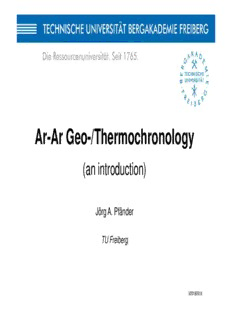
Ar-Ar Geo-/Thermochronology PDF
Preview Ar-Ar Geo-/Thermochronology
Ar-Ar Geo-/Thermochronology ((aann iinnttrroodduuccttiioonn)) Jörg A. Pfänder TU Freiberg V20160616 Ar-Ar Geo-/Thermochronology Introduction: K-Ar dating Principle: K-Ar Method: Electron capture decay of 40K to 40Ar: fifi 4400 4400 KK AArr (half life = 11.9 Ga) 19 18 Aldrich & Nier (1948): K-rich minerals have elevated 40Ar/36Ar ratios when compared to atmospheric argon – this suggests that 40Ar is a decay product of 40K (Aldrich L.T. & Nier, A.O., 1948: Argon 40 in Potassium Minerals, Phys. Rev. 74, 876–877 – Nachweis des Zerfalls von 40K zu 40Ca und 40Ar!) Ar-Ar Geo-/Thermochronology Introduction: K-Ar dating ! Ar-Ar Geo-/Thermochronology Introduction: K-Ar dating Radioactive decay scheme of natural 40K Half life of the 40K – 40K ln(2) 40Ar decay: 10.32 % (ec1) l = T 11.93 Ga 1/2 l = 0.581x10-10 1/a ec ~0.001 % Half life of the 40K – 4400CCaa ddeeccaayy:: 1.397 Ga 0.16 % (ec2) 89.52 % l = 4.962x10-10 1/a b Half life (T ) of 40K: 1/2 1.25 Ga 40Ca l = 5.543x10-10 1/a tot 40Ar + + - fi fi + + - p e n n p e Ar-Ar Geo-/Thermochronology Introduction: K-Ar dating 40K branched decay to 40Ca (89.52%) and 40Ar (10.48%) in the chart of nuclides: Isotopes + + - fi p e n fi + + - n p e Ar-Ar Geo-/Thermochronology Introduction: K-Ar dating Abundances of naturally occuring Ar isotopes: 36Ar = 0.3364 ± 0.0006 % Atmosphere: ~1% Argon 38Ar = 0.0632 ± 0.0001 % with 40Ar/36Ar ~ 298.56 ± 0.31 (Lee et al., 2006) 40Ar = 99.600 % Abundances of naturally occuring K isotopes: 39K = 93.2581 % Only ~0.011% of K consists of 40K, 40K = 0.01167 % and only ~10% of 40K decay to 40Ar 41K = 6.7302 % BUT K is a major element in numerous rock forming minerals! Ar-Ar Geo-/Thermochronology Introduction: K-Ar dating What can be dated by K-Ar and Ar-Ar? Basically all K-bearing rocks and minerals ! Commonly used minerals: K-feldspar, biotite, muscovite, hornblende, plagioclase Whole rocks: Dateable age range: Basalte, rhyolite, tuffs, meteorites, …. ~~11000000 aa uupp ttoo 44..66 GGaa Sanidine, anorthoclase Plagioclase Leucite Biotite, Muscovite Amphibole Whole rock 1000 a (!) Range of applicability [Ma] Ar-Ar Geo-/Thermochronology Introduction: K-Ar dating Amount of radiogenic 40Ar in a sample/mineral is proportional to: K-concentration in sample/mineral Age of sample/mineral AAmmoouunntt ooff rraaddiiooggeenniicc 4400AArr ((4400AArr**)) iinn aa ssaammppllee oorr mineral as a function of time and remaining K-concentration: l 40 Ar*= ec 40K (el tot t - 1) l = l + l + l = 5.543· 10- 10 l tot ec1 ec2 b tot l 0.581· 10- 10 = = ec 0.1048 = + 40 Ar 40Ar 40Ar* l 5.543· 10- 10 tot tot i Ar-Ar Geo-/Thermochronology Introduction: K-Ar dating Leading to the classical K-Ar isochron diagram: one sample = one age ! l slope = ec (el t - 1) tot l tot slope ~ age best fit iissoocchhrroonn 40Ar 40Ar 40K l = + ec (eltott - 1) 36Ar 36Ar 36Ar l i tot = + y b x m datapoints (40Ar/36Ar) i K-Ar whole-rock isochron of a tuff sample – each datapoint represents a split of the same sample Ar-Ar Geo-/Thermochronology Introduction: K-Ar dating Requirements to obtain a K-Ar age: Decay constant‘s are constant over Earth‘s history 40Ar in a sample is only radiogenic (40Ar*) oorr non-radiogenic Ar can be determined and corrected for Samples/minerals remain a closed system after crystallisation/cooling
Description: